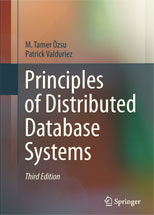
 |
Principles of Distributed Database Systems, Third EditionM. Tamer Özsu
|
The third edition is finally out... It has been ten years since the release of the second edition -- it took a while, but we are very happy with the results. Through this site, we will make available presentation slides, solutions to some of the exercises, and (hopefully few) errors. These are accessible through the links on the left. The slides are downloadable by anyone and they are also available from Springer site (click here). However, access to solutions to exercises is restricted to those academics who have adopted the book for a course. Therefore, we ask you to register and provide some evidence of the course adoption. We also ask you not to put the solutions online in any format or to distribute them to anyone who may then post them online.
The book is available from Springer, Barnes & Noble, Chapters-Indigo (in Canada), and, of course, Amazon.
The book is almost a complete re-write. We kept the fundamental principles that have been there since the first edition, but they are updated. The end result is a book that has been heavily revised -- while we maintained and updated the core chapters, we have also added new ones. The major changes are the following:
The resulting manuscript strikes a balance between our two objectives, namely to address new and emerging issues, and maintain the main characteristics of the book in addressing the principles of distributed data management.
The third edition is coming out at a time when there is renewed interest in distributed data management. The last ten years have seen an accelerated investigation of distributed data management technologies spurred by advent of high-speed networks, fast commodity hardware, very heavy parallelization of hardware, interest in cloud computing, and, of course, the increasing pervasiveness of the web. We hope the book contributes the the renewed discussion on these topics.
As always, we would very much like to hear from you. Let us know what you think we did right and what we got wrong; what you would like to be included in the next edition and what no longer needs to be included. Of course, let us know if you discover any errors.
M. Tamer Özsu (tamer.ozsu@uwaterloo.ca)
Patrick Valduriez (Patrick.Valduriez@inria.fr)